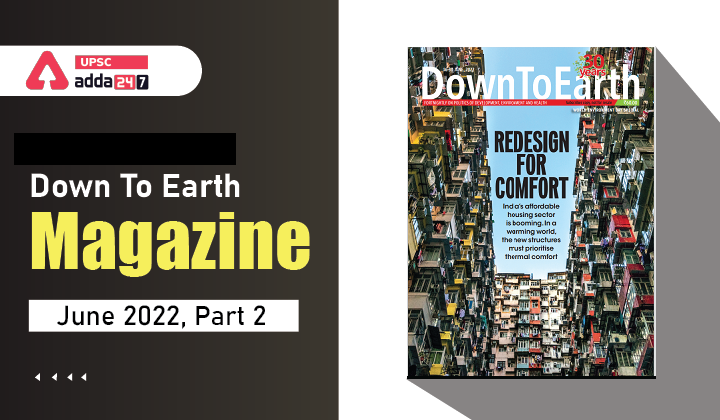Table of Contents
Down To Earth is a fortnightly magazine focusing on politics of environment and development, published in New Delhi, India.
UPSC Previous years’ questions on Development, Environment, Health and Disaster Management give us a clear idea about the increased importance of DTE magazine.
DTE Magazine is one of the most important and indispensable source for UPSC Civil Services Exam Preparation. Keeping this in mind, here, we come with ”Gist Of Down To Earth Magazine” which covers important environmental current affairs articles in smooth pointed form, keeping in mind the demand of UPSC aspirants.
Rising Urban Temperature: Introduction
- Heatwaves become more frequent and can be 25 times longer in the coming decades, between 2036 and 2065, warns the G20 Climate Risk Atlas for India, released in 2021.
- While extreme heat beyond 35 D. C. can lead to serious health problems, its effects get compounded when relative humidity also increases.
- The Urban part is more vulnerable to this change.
Rising Urban Temperature: What is Thermal Stress?
In a hot weather, our body works to maintain tolerable temperature by sweating. But if it is humid, the sweat cannot evaporate as quickly, crippling the body’s cooling method. This adds to thermal stress and can cause medical emergencies.
Rising Urban Temperature: What is a Heatwave?
- Heatwave, which IMD defines as a condition when the maximum air temperature departure is 4.5 D.C. or more from normal and can last for several days, can increase the risk of fatality.
- The death rate due to heatwave is second to the death toll caused by lightning among hazard linked deaths.
Rising Urban Temperature: How Urban areas are more vulnerable to heatwaves?
- The most brutal impact of heatwaves is felt in cities, where the high density of buildings, asphalt and concrete, and
minimal vegetation create extra sweltering “heat islands”. - Waste heat from air conditioners, exhaust from vehicles and industrial processes and reflected heat from glazed façades compound the effect.
- This makes urban areas 4-12 D.C. warmer than the surrounding areas with green cover.
- The UN Environment Programme (unep) in its guide “Beating the Heat: A Sustainable Cooling Handbook for Cities”, published in 2021, warns that by 2100, cities worldwide could warm up by 4°C on average—more than double the 1.5°C goal set under the Paris Agreement—because of heat-island effect.
- India’s urban population will double to 877 million between 2018 and 2050, estimates a 2018 report by the UN—and temperatures are rising.
Rising Urban Temperature: What is India Cooling Action Plan (ICAP)?
The India Cooling Action Plan (icap), launched by the Union Ministry of Environment, Forest and Climate Change in 2019, aims to address concerns related to rising temperature by reducing cooling demand of the country by 20-25 per cent and cooling energy requirement by 25-40 per cent by 2037-38.
Rising Urban Temperature: What Should be done?
Change tack from energy efficiency to thermal comfort
Currently, energy efficiency building code for residential buildings, called Eco Niwas Samhita 2018, is in place but it is not mandatory.
Building orientation material hold the key
- Appropriate building orientation can substantially lower heat gain.
- It has been found that Buildings that have façade facing east-west gain up to 20 per cent more heat than those facing north-south.
- The heat gain dropped by 40 per cent, even with the same building design, when the material was changed in the simultation model from concrete blocks to fly ash bricks.
Don’t isolate buildings from surroundings
- It is necessary to consider a building withinthe context of the layout of the building clusters for efficient air movement and daylight penetration.
- Air movement can improve if the buildings are staggered, have mid-rise height, clustered diagonally to the wind flow direction, and have increased distance between buildings.
- Height of buildings and the distance between them become a crucial parameter for ideal daylight penetration.



 TSPSC Group 1 Question Paper 2024, Downl...
TSPSC Group 1 Question Paper 2024, Downl...
 TSPSC Group 1 Answer key 2024 Out, Downl...
TSPSC Group 1 Answer key 2024 Out, Downl...
 UPSC Prelims 2024 Question Paper, Downlo...
UPSC Prelims 2024 Question Paper, Downlo...





